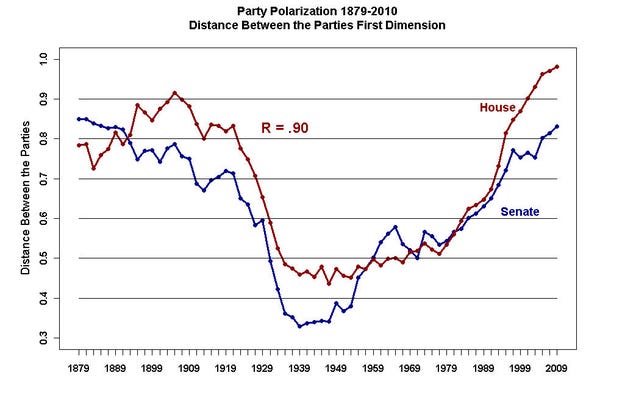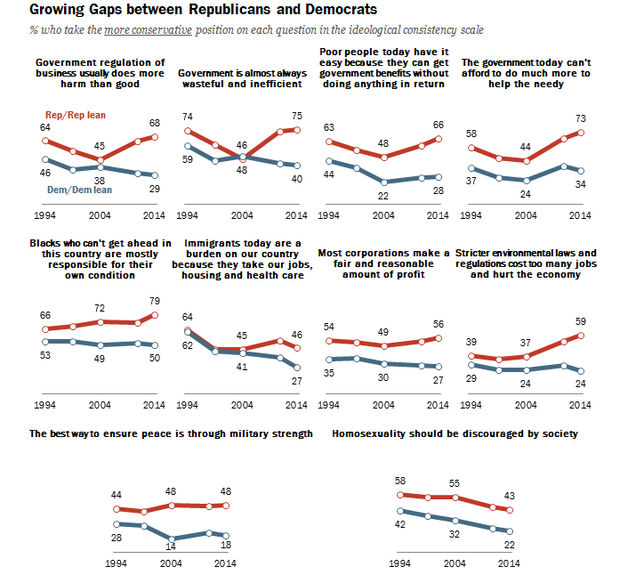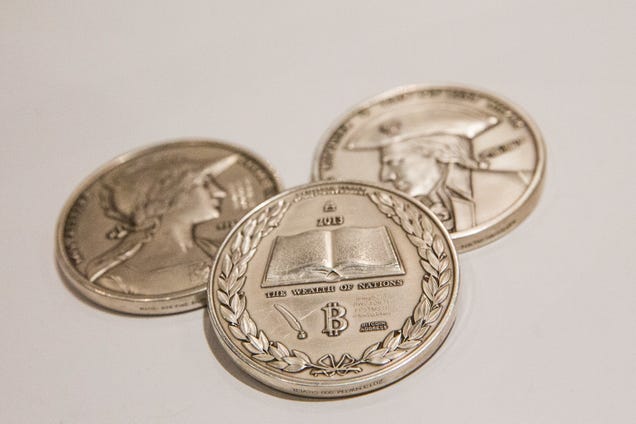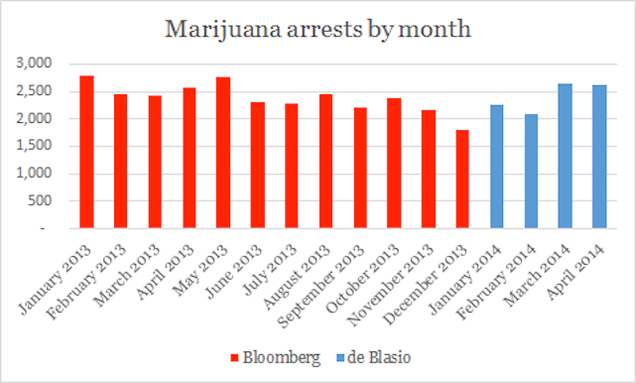
A new survey from the Pew Research Center reveals that political polarization in the United States has reached a dangerous extreme. The gap between what Democrats and Republicans believe is enormous, with almost no center ground. We haven't seen such strong polarization since the Civil War.
Photo by Andrew Kuznetsov
At this point, you might be thinking, "bullshit." We're seeing more polarization than the 1960s, with Vietnam and the culture wars? The 1950s, with segregation and McCarthyism? The answer is yes, those were decades of profound ideological division with the United States. But they weren't the apex. Political polarization has grown more pronounced with each passing decade, until we've reached…well, now.
A quick visualization (below):

In 2012, political scientists Nolan McCarty, Keith Poole and Howard Rosenthal quantified the degree to which Democrats and Republicans have become ideologically homogenous and separated from one another. In the chart below, which portrays voting patterns in Congress, high numbers represent polarization—the House and Senate vote predictably along party lines, even on issues that are not typically sources of division—while low numbers represent voting that was less predictable and more mixed, indicating there were opportunities for compromise and bipartisan coalitions. The post-Civil War, Reconstruction era saw divisions gradually erode as we entered into the two World Wars and the Depression, and picked up again as we moved into the latter half of the century.
So, in one sense, the results of the new Pew survey were not entirely unexpected—but they still manage to surprise, in terms of the extent to which our ideologies have come to define us.
Enemy Mine
According to the Pew survey, during the last two decades, an increasing number of people have chosen to veer Right or Left in their political orientation:
The overall share of Americans who express consistently conservative or consistently liberal opinions has doubled over the past two decades, from 10% to 21%. And ideological thinking is now much more closely aligned with partisanship than in the past. As a result, ideological overlap between the two parties has diminished: Today, 92% of Republicans are to the right of the median Democrat, and 94% of Democrats are to the left of the median Republican.
This translates into a growing number of Republicans and Democrats who are on completely opposite sides of the ideological spectrum, making it harder to find common ground in policy debates. The share of Democrats who hold consistently liberal positions has quadrupled over the course of the last 20 years, growing from just 5% in 1994 to 13% in 2004 to 23% today. And more Republicans are consistently conservative than in the past (20% today, up from 6% in 2004 and 13% in 1994), even as the country as a whole has shifted slightly to the left.
Partisan animosity has increased substantially over the same period. In each party, the share with a highly negative view of the opposing party has more than doubled since 1994. Most of these intense partisans believe the opposing party's policies "are so misguided that they threaten the nation's well-being."
On measure after measure – whether primary voting, writing letters to officials, volunteering for or donating to a campaign – the most politically polarized are more actively involved in politics, amplifying the voices that are the least willing to see the parties meet each other halfway.
The majority of Americans don't share these sentiments. They don't adhere to uniformly conservative or liberal views. They don't see either party as a threat and they don't see compromise as surrender. So why do we see so much gridlock in Washington? It appears that apathy is also playing a role in polarization. The political center has become increasingly disengaged, ceding the playing field to the most ideological Americans, whose voices have become louder through increased activism.
The two charts below illustrate the median divide between the general population and those who are politically active:


Conveniently, for Pew, their survey came out at the precise time that Eric Cantor suffered a surprise defeat by a Tea Party challenger. The story of Cantor's downfall—the first-ever primary thumping of a majority leader since the position was created in 1899—is a microcosm of the political dynamics that Pew describes. As David Weigel observes in Slate:
Less than a month after Obama's second inauguration, Cantor debuted a vision for a new GOP that would "make life work." What if the GOP incentivized people to buy better health care and seek more useful college degrees? What if it went a little easier on immigrants?
None of this was "liberal," per se. It just wasn't what the conservative base had asked for, campaigned for, voted for. It was the agenda of the establishment…. Cantor went with Democrats on a three-day tour to boost reform; he sought out a number of ways to avoid a shutdown, including a failed gambit to split the "defund Obamacare" vote from a separate appropriations vote.
Conservatives came to view Cantor as at best unreliable, at worst an outright enemy.
Life on the Fringe
Pew also found that "ideological silos" are now common on both the left and right. People with down-the-line ideological positions disagree over where they want to live, the kind of people they want to live around and even whom they would welcome into their families.
For instance:
- Liberals would rather live in cities, while conservatives prefer rural areas and small towns.
- Liberals are more likely than conservatives to say racial and ethnic diversity is important in a community.
- Conservatives are more likely than liberals to want to live in a place where many people share their religious faith.
- 15% of Democrats and 17% of Republicans would be unhappy welcoming someone from the other party into their family.
- Just 35% of Americans say most of their close friends share their views on government and politics.
That last indicator is an important one, because it reveals the extent to which those on the Left and Right have hunkered down in their silos. While only 35% of Americans say most of their close friends share their political beliefs, among conservatives, roughly twice as many say most of their close friends share their views as say many of their friends do not (63% vs. 30%). Among liberals, that attitude is less extreme, but still a plurality: 49% vs. 39%.
As Pew notes:
These indicators suggest that there is a tendency on the left and the right to associate primarily with like-minded people, to the point of actively avoiding those who disagree. Not surprisingly, this tendency is also tightly entwined with the growing level of partisan antipathy. In both political parties, those with strongly negative views of the other side are more likely to be those who seek out compatible viewpoints.
The Political Climate
The Pew survey measured the extent of political polarization around 10 key issues that are traditional ideological flashpoints, such as the size of government, protecting the environment, minorities and military strength:

Disappointingly, the survey didn't touch upon any science-related issues, including the one that is arguably among the most divisive today: climate change. That said, the findings of the poll lend credence to previous studies that have examined the division over climate change. Those studies found that views on the issue had less to do with the actual scientific findings than it did with ideology—and, more specifically, how people formed their opinions.
One of the most respected and cited studies was written by political scientists Aaron M. McCright and Riley E. Dunlap. They examined polarization over climate change by analyzing data from 10 nationally representative Gallup Polls between 2001 and 2010.
Their results showed that the percentage of conservatives and Republicans who believed in global warming had already begun to decline—from roughly 50% in 2001 to about 30% in 2010, whereas the corresponding percentage of liberals and Democrats increased from roughly 60% in 2001 to about 70% in 2010.
What explained this outcome? McCright and Dunlap argued that the divide over climate change was almost a forgone outcome:
American conservatives champion ideals of individual freedom, private property rights, limited government, and the promotion of free markets, while American liberals promote collective rights, view market regulation as crucial for protecting citizens and public goods, seek to increase the quantity and quality of government's social service provision, and support governmental intervention to extend rights to previously underprotected groups. Environmental protection typically entails governmental intervention into markets and restrictions on property rights, challenging conservative values, but is consistent with liberals' view that protecting collective welfare is a proper role of government.
Compared with local environmental problems such as water and air pollution, global environmental problems like climate change pose a stronger challenge to conservatives' faith in unfettered industrial capitalism as the desirable and inevitable path to progress. More specifically, the possibility of an internationally binding treaty to curb greenhouse gas emissions is viewed as a direct threat to sustained economic growth, the spread of free markets, the maintenance of national sovereignty, and the continued abolition of governmental regulations—key goals of conservatives. Thus, conservatives and Republicans can be expected to question the scientific consensus on climate change, as this body of knowledge highlights the deleterious consequences of industrial capitalism. On the other hand, liberals and Democrats can be expected to accommodate evidence of climate change and the necessity of dealing with it, as employing governmental regulations in an effort to reduce the danger of climate change is likely to seem quite legitimate to them.
McCright and Dunlap, however, believe that the general public was more likely to be polarized on this issue because the debate over climate change has often taken the form of citing opposing scientific theories. The media gave "equal time" to climate change deniers, even though they were a minority opinion within scientific circles. As a result, from the perspective of the general public, the issue became increasingly ambiguous—and, when faced with ambiguous information, people tend to turn toward political elites to help them form their opinions.
In the parlance of political scientists, this is known as "party sorting" theory —a top-down process wherein the more visible and active members of a party establish views on an issue and then communicate the accepted positions to the public. The increasing divide between both the parties and the ideological elites from the Left and the Right on climate change over the past two decades has made it easier for American citizens to sort themselves along both ideological and partisan lines.
If that's so, the polarization over this issue will continue until the political center becomes more assertive—or, ocean waves begin smacking against the stairs of the Capitol Building.





























